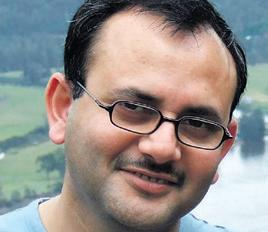
4 minute read
A wealth of ideas at TEDx Sydney
from 2013-05 Sydney (2)
by Indian Link
From Braille to an activist in asylum to undernourishment in India, all topics provided food for thought at this interesting forum
BY HASNAIN Z AHEER
If you are unaware of TED, it stands for Technology Entertainment Design and is a series of conferences that were initiated in 1984. Speakers who were often distinctive achievers or overachievers, especially in the worlds of technology, entertainment and design presented their key ideas, discoveries and inventions in 20 minute speeches, which was just enough to succinctly present their ideas in reasonable detail.
TED is held in the West Coast of the United States in Spring and in the UK each Summer, but their hugely popular website TED Talk (www.ted.com) hosts all of these speeches and talks that are relished by millions. Countless TEDx conferences are held throughout the world which are hosted by local enthusiasts under license from TED.
The most popular TEDx in Australia is TEDx Sydney which was held on May 4 at the Sydney Opera House in the presence of more than 2,000 people on-site, and thousands more who joined the video feed remotely, via the internet and through studios. Of course, thousands more will view these talks on the internet in years to come.
Indian Link attended TEDx and it certainly was an eventful day. “The hunger for ideas, conversation and challenging questions is so breathtaking and gratifying,” said Remo Giuffre, founder of TEDx Sydneym, who opened the conference. “This is the City of Ideas. No other TEDx community in the world has this engagement”
The very first speaker, Prof Ron McCallum, brought the house down with a standing ovation when he described the advancement of technology for the blind, and planted the seed for a renewed appreciation for Braille. He played a piece of audio to the audience and then replayed it at the speed at which he read it in Braille.
Prof McCallum has worked a lifetime to bring Braille texts to Latin America and other poor parts of the world.
Alice Gorman, a space archaeologist, talked about space research, orbital debris and Australia’s contribution to space research. Jennifer Robinson talked about Benny Wenda, a West Papuan activist in asylum that she has represented.
This was followed by a curious piece of music mixed in Maths –The Fibonacci sequence, played out percussion style by musical mathematician
Greg Sheehan. Anyone who likes data would like Simon Jackman. He is a political scientist who applies big data, another name for data analytics and statistics, to politics. He described with smart data and charts, how internet polling presents accurate analysis of voter perceptions and how useful today’s surveys are in the age of ubiquitous digital connections.
Danny Kennedy, a social entrepreneur credited Australians with something they would not ordinarily believe they have achieved. He mentioned how Australia has one of the world’s best take-up of solar technology, with more than a million solar roofs on Australian homes. He told us how a billion people still use kerosene as their primary source of light. His key message was, “We can abandon fossil fuels by turning on the sun”.
Lisa Murray, City of Sydney historian, told the audience about how she manages records. It was so easy when it was all paper, you just had to ensure it was secure and protected. But the problems are complex with today’s ‘borndigital records’ which disappear into a ‘digital black hole’ as systems change and media changes.
She mentioned how the NSW government has funded digital archives until June 2013, and appealed for a renewed emphasis on digital archiving of records.
So, was there a bit of India in this year’s TEDx? Yes, there was, if only a bit.
Bill Pritchard, an economic geographer, presented his extensive research on hunger and under-nourishment in India. He mentioned how the natural response to hunger alleviation is to grow more food, as well as agricultural research. But the astonishing fact is that the world produces enough to feed all of us. Despite this, 870 million still remain undernourished, with a large number of these being in India. He mentioned how the previous decade of fast growth has led to a very marginal fall in undernourishment in India - a very distressing outcome. He traced the reasons to the socio-economic field, as opposed to a simplistic food production problem, and described how a three-pronged strategy is based on securing livelihood, building capabilities and entitlements.
Pritchard recommended creating conditions for people to stake a claim in economic growth. This requires building their capabilities for employment to spin them away from a vicious cycle of under-nourishment that stunts their capability to work, which leads to under-nourishment in the next generation. In terms of entitlement, he cited the pending legislation on a right to food as a game changing development that would make Governments tackle this problem head-on, as they would be legally liable for a lack of food.

The other major mention of India was a Bharatnatyam performance by Rajeswari Sainath which enthralled the audience. Trained in the purist Pandanallur tradition of Bharatanatyam by Indira Rajan of Chennai, Rajeswari has been performing from the age of 10.
One may argue with the curators on the inclusion of certain talks such as West Papua freedom activism when there are many more serious conflicts going on in the world. Or not enough representation of the digital revolution going on in our society. But one may understand the difficulty they must be facing, accommodating different interests and compiling a broad event like this.
There were a number of other talks and performances, too many to describe in these pages. Fortunately, these are on the TEDx Sydney website, so you may have a bite of current Australian contemporary art, culture and issues, or get a taste of ‘ideas worth spreading’.
TEDx Sydney website: http://tedxsydney.com










